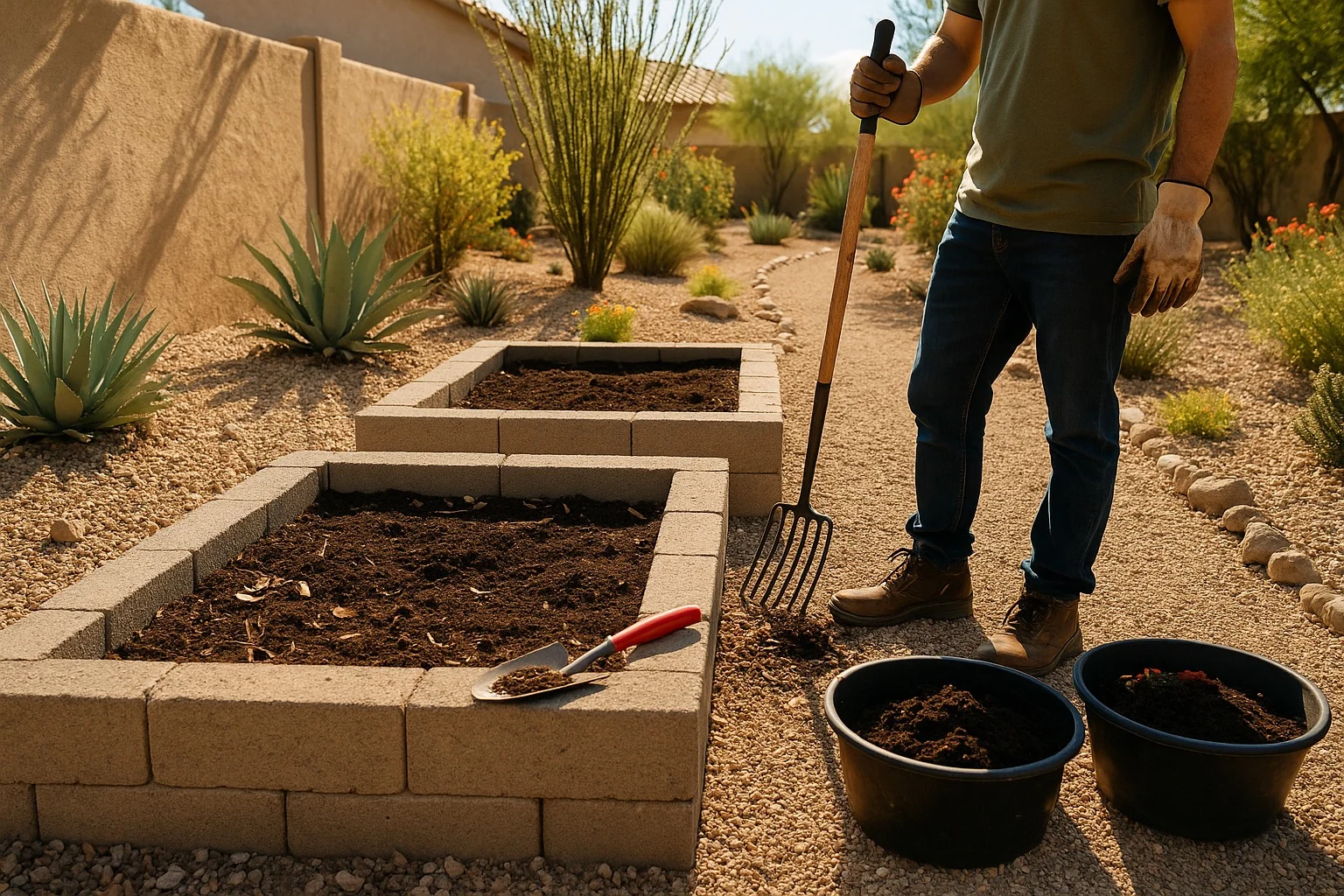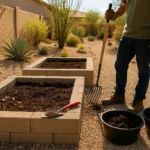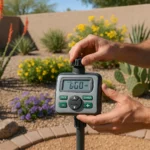As the desert winter gives way to spring warmth in Queen Creek, it’s time to roll up our sleeves and prepare our gardens for the productive growing season ahead. Spring garden cleanup isn’t just about aesthetics—it’s a crucial reset that sets the foundation for healthy plants and bountiful harvests in our unique Arizona climate. Whether you’re tending to raised beds, container gardens, or in-ground plantings, a thorough spring refresh removes winter debris, addresses pest issues, and prepares your soil for optimal growing conditions.

Understanding Queen Creek’s Spring Transition
Queen Creek’s spring arrives earlier than in many parts of the country, with temperatures beginning to climb as early as February. This early warming period gives us a head start on garden cleanup, but it also means we need to act quickly before the intense heat arrives. Our unique desert climate creates specific challenges and opportunities for spring garden preparation.
Unlike gardeners in cooler regions who might wait until April or May, Queen Creek residents should ideally complete most spring cleanup tasks by early March. This timing allows you to prepare beds before our brief but beautiful spring growing window and helps establish plants before summer’s scorching temperatures arrive. The transition from winter to spring in our region is subtle—you might notice wildflowers appearing along roadsides, citrus trees finishing their fruit production, and nighttime temperatures consistently staying above 45°F.
Pay attention to these natural indicators rather than following a strict calendar date. Our last frost typically occurs in late January or early February, making mid-February to early March the ideal window for comprehensive garden cleanup activities. This proactive approach gives you plenty of time to prepare for summer heat-resistant plantings while taking advantage of our pleasant spring temperatures for garden work.
Essential Tools for Spring Garden Cleanup
Before diving into your garden cleanup project, gather the right tools to make the job efficient and effective. For Queen Creek gardens, I recommend having pruning shears, loppers for thicker branches, a sturdy rake, a hoe for weeding, a garden fork for turning soil, and a wheelbarrow or garden cart for hauling debris. Quality garden gloves are essential in our desert environment to protect against thorns, sharp plant materials, and potentially harmful insects that may have overwintered in your garden.
Consider investing in a soil moisture meter and pH tester to evaluate your garden’s condition after winter. These diagnostic tools help identify any soil amendments needed before spring planting. A good-quality garden knife or soil knife is invaluable for dividing perennials and working in tight spaces like raised beds. For larger Queen Creek properties, a gas or electric leaf blower can help clear winter debris efficiently from pathways and garden borders.
Don’t forget basic cleaning supplies for your tools. A bucket with a solution of one part bleach to nine parts water works well for disinfecting pruning tools between plants, preventing the spread of any diseases that might be present in your garden. Having these tools ready before you begin makes the cleanup process more organized and prevents delays once you’ve started the project.
Clearing and Assessing Raised Beds
Raised beds are particularly popular in Queen Creek gardens because they provide better drainage in our clay-heavy soils and warm up faster in spring. Begin your raised bed cleanup by removing all plant debris, including spent annuals, vegetable plants, and any weeds that managed to establish during winter. Pull these completely, including roots, and inspect carefully for pests or disease symptoms. In our climate, watch specifically for signs of root rot from winter rains, whitefly eggs on the undersides of leaves, and evidence of rodent nesting.
Once cleared, take time to inspect the structural integrity of your raised beds. Our intense summer heat and occasional heavy monsoon rains can cause wooden beds to deteriorate over time. Check for warped boards, loose fasteners, or signs of wood rot, especially at soil contact points. Repair or replace damaged components now, before filling with fresh soil amendments. For metal raised beds, look for rust spots that might need treatment before the growing season.
After assessment, use a garden fork to gently turn the existing soil, breaking up any compacted areas without disturbing the bed’s overall structure. This is the perfect time to send a soil sample for testing if you haven’t done so recently. Queen Creek’s alkaline soils often benefit from specific amendments, and a test will guide you toward the right corrections for your particular garden conditions rather than applying amendments blindly.
Rejuvenating Garden Soil for Desert Growing
Queen Creek’s native soil presents challenges for gardeners—typically alkaline, often lacking organic matter, and sometimes containing caliche layers that impede drainage. Spring is the ideal time to address these issues before the growing season begins. For raised beds, I recommend adding 2-3 inches of quality compost to the top of your existing soil. This organic matter improves both drainage and water retention while slowly correcting pH issues. Work this layer into the top 6-8 inches of soil using your garden fork or a small tiller.
For in-ground gardens, consider a more targeted approach. After clearing winter debris, apply compost in planting areas rather than trying to amend the entire garden at once. In our desert climate, creating rich planting pockets is often more effective than broad amendments. If your soil test indicates high alkalinity (common in Queen Creek), incorporate sulfur products specifically designed for Arizona soils. These work gradually to reduce pH levels over time.
Don’t overlook the importance of mulch in our desert environment. After soil amendments are incorporated, apply a 2-3 inch layer of organic mulch like shredded bark, straw, or compost to your garden beds. This protective layer reduces water evaporation, moderates soil temperature, and gradually breaks down to continue improving soil structure. For vegetable gardens, lighter mulches like straw work well, while ornamental beds might benefit from longer-lasting wood chip mulches that need less frequent replacement.
Pruning and Trimming for Spring Growth
Spring pruning requirements in Queen Creek differ significantly from those in cooler climates. Many of our desert-adapted plants benefit from pruning in late winter to early spring, just as new growth begins to emerge. For ornamental shrubs that flower on new wood, like lantana, Texas sage, and yellow bells, cut back by about one-third to encourage dense, healthy growth. These plants can be quite aggressive in our climate, and proper pruning prevents them from becoming woody and unproductive.
Fruit trees require special attention during spring cleanup. Citrus trees generally need minimal pruning—focus only on removing dead wood, crossing branches, and any growth pointing toward the center of the tree. Stone fruits like peaches and apricots, which grow well in Queen Creek, should be pruned to maintain an open center that allows sunlight to reach all parts of the tree. Complete fruit tree pruning by late February to avoid stress during the bloom period.
For perennial vegetables like artichokes and asparagus, remove any dead foliage and apply a fresh layer of compost around the base of the plants. Ornamental grasses, which add wonderful texture to Queen Creek landscapes, should be cut back to about 6-8 inches above ground level before new growth appears. Use sharp pruning tools and make clean cuts to minimize stress on plants and reduce disease entry points. Remember that proper pruning now leads to stronger growth throughout the spring and summer seasons.
Managing Pests and Diseases During Cleanup
Spring cleanup provides an excellent opportunity to get ahead of potential pest and disease issues before they become problematic. As you clear debris, remain vigilant for signs of overwintering pests common in Queen Creek gardens. Check the undersides of remaining leaves for aphid eggs, inspect woody stems for scale insects, and look for evidence of rodent activity around the bases of plants and in raised bed corners. Remove and dispose of any obviously infected or infested plant material rather than composting it.
For organic gardens, consider applying beneficial nematodes to the soil during spring cleanup. These microscopic organisms help control soil-dwelling pests like fungus gnat larvae and root-eating grubs that can damage young plants. Another preventative measure is applying diatomaceous earth around newly cleaned beds to create a barrier against crawling insects. This natural product is particularly effective in our dry climate but needs reapplication after irrigation or rain.
If your garden experienced disease issues last season, such as powdery mildew on squash plants or bacterial spot on tomatoes, take preventative measures during cleanup. Apply a copper-based fungicide to the soil where affected plants grew, and plan to rotate crops to different locations in your garden this season. Some Queen Creek gardeners find that a diluted solution of hydrogen peroxide (one part 3% hydrogen peroxide to ten parts water) sprayed on garden beds helps sanitize the soil surface and reduce fungal spores before spring planting begins.
Irrigation System Maintenance and Updates
Efficient irrigation is critical for garden success in Queen Creek’s arid climate, making spring the perfect time to inspect and update your watering systems. Begin by checking all drip emitters, soaker hoses, and sprinkler heads for clogs or damage that may have occurred during winter. Flush the system to clear any sediment that has accumulated, and verify that water is flowing properly to all areas of your garden. Replace any cracked or damaged components before the high-demand summer season.
Consider upgrading to more efficient irrigation methods if you haven’t already. Drip irrigation delivers water directly to plant roots, reducing evaporation and water waste compared to overhead sprinklers. For raised beds, installing dedicated drip lines with appropriate emitter spacing ensures consistent moisture throughout the growing season. Smart irrigation controllers that adjust watering schedules based on weather conditions can reduce water usage by 20-30% while maintaining plant health.
Spring is also the ideal time to reassess your garden’s hydrozones—grouping plants with similar water needs together. As you plan your spring plantings, organize your garden so that thirsty vegetables and ornamentals share irrigation zones, while drought-tolerant native plants are grouped separately with less frequent watering. This thoughtful organization not only conserves water but also promotes healthier plants by providing appropriate moisture levels for each species’ specific requirements.
Planning Your Spring Planting Schedule
With your garden beds cleaned and prepared, it’s time to plan your spring plantings. Queen Creek’s growing calendar differs significantly from national gardening guides, with our primary growing seasons being spring and fall rather than summer. Early spring (February-March) is ideal for cool-season crops like peas, lettuce, spinach, and root vegetables. These crops can mature before summer heat arrives, giving you a bountiful harvest in April and May.
For warm-season vegetables like tomatoes, peppers, and squash, wait until mid to late March when soil temperatures have warmed consistently and the risk of cool nights has passed. These summer crops need time to establish before intense heat arrives but can continue producing with proper care through early summer. Consider heat-tolerant varieties specifically developed for desert conditions, such as ‘Phoenix’ tomatoes or ‘Arizona’ eggplant, which perform better in our climate than varieties developed for cooler regions.
Don’t overlook the opportunity to add heat-loving perennial herbs during spring planting. Rosemary, sage, thyme, and oregano establish well when planted in spring and provide years of harvests with minimal care. For ornamental beds, spring is perfect for adding desert-adapted perennials like penstemons, globe mallow, and desert marigold, which will establish before summer and provide beautiful blooms for years to come. Creating a planting calendar specific to Queen Creek’s growing conditions helps ensure success and extends your productive gardening season.
Seasonal Container Garden Refresh
Container gardens offer versatility in Queen Creek yards and benefit tremendously from a thorough spring refresh. Start by completely emptying pots of last season’s soil and plants. Scrub containers with a solution of one part bleach to nine parts water to sanitize and remove mineral deposits that commonly build up in our hard water region. Allow pots to dry completely before refilling with fresh potting mix specifically formulated for container gardening in arid climates.
When selecting containers for spring planting, consider materials that perform well in our intense summer heat. Thick ceramic, concrete, or glazed pots provide better insulation for root systems than thin plastic containers, which can heat up rapidly in direct sun. For vegetables and herbs in containers, choose pots at least 12 inches deep to provide adequate room for root development. Position containers where they’ll receive morning sun but afternoon shade during the hottest months to extend your growing season.
Spring is the perfect time to experiment with creative container combinations that thrive in Queen Creek conditions. Consider drought-tolerant succulents paired with trailing ice plant for sunny locations, or combine colorful calibrachoa with trailing bacopa and upright angelonia for a stunning display that holds up well in spring conditions. For edible container gardens, try pairing compact tomato varieties with basil and marigolds—the companions help deter pests while making efficient use of container space. Remember that all container plantings in our climate will need more frequent watering than in-ground gardens, so factor this maintenance requirement into your spring planning.
Maintaining Momentum After Spring Cleanup
The work invested in spring garden cleanup sets the stage for a successful growing season, but maintaining that momentum requires consistent attention as temperatures rise. Establish a regular maintenance schedule that includes monitoring for pests weekly, checking soil moisture levels every few days, and applying supplemental fertilizer as needed. In Queen Creek’s climate, staying ahead of maintenance tasks prevents small issues from becoming major problems during intense summer heat.
Consider implementing a garden journal system to track what works well in your specific microclimate. Record planting dates, varieties used, weather patterns, and harvest results to build knowledge for future seasons. Many Queen Creek gardeners find that taking weekly photos of their gardens helps document growth patterns and identify potential issues before they become severe. These records become invaluable resources for planning next year’s spring cleanup and planting schedule.
Finally, prepare for the inevitable summer transition by having shade cloth ready to deploy over sensitive plants when temperatures consistently exceed 100°F. Installing this protection during late spring helps extend your growing season by several weeks. Mulch maintenance is also critical—check mulch depth monthly and replenish as needed to maintain the 2-3 inch protective layer that moderates soil temperature and conserves moisture. With thoughtful follow-through after your spring cleanup efforts, your Queen Creek garden will reward you with productivity and beauty throughout the growing season.





